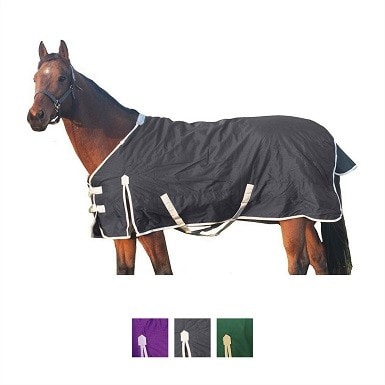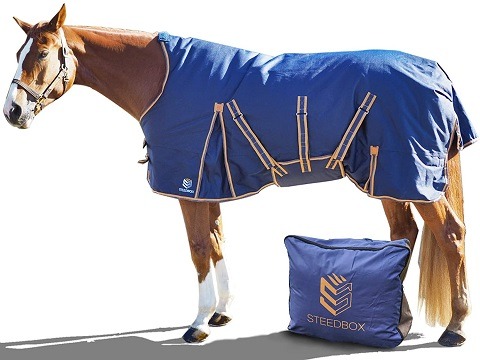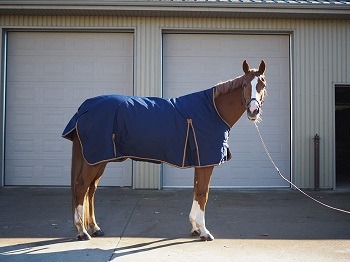
That being said, they are all used in different circumstances and at different times. Regardless of what type of blanket you are looking for, it should be comfortable and offer warmth without restricting movement or causing any kind of reaction from your horse.
You’ll want to check the material, ensure you buy the right size, and look for blankets that will withstand the elements and regular use and last without having to be replaced every few weeks. Below are reviews of six of the best horse blankets so that you can find the one that best meets your requirements.
A Quick Comparison of Our Favorites in 2024
| Image | Product | Details | ||
|---|---|---|---|---|
| Best Overall |

|
Derby Originals 600D Turnout Horse Blanket |
|
Check Price |
| Best Value |

|
Shires Tempest Original Lite Turnout Blanket |
|
Check Price |
| Premium Choice |

|
SteedBox Horse Winter Turnout Blanket |
|
Check Price |

|
AJ Tack Wholesale Horse Turnout Blanket |
|
Check Price | |

|
Tough 1 Timber 1200D Waterproof Turnout Blanket |
|
Check Price |
The 6 Best Horse Blankets
1. Derby Originals 600D Turnout Horse Blanket – Best Overall
The Derby Originals 600D is a waterproof turnout winter blanket. It is made from 250 grams of poly-fill insulation material contained in a 600D nylon. The nylon lining has no back seam which further enhances the waterproof ability of the nylon material. It has double buckles and elastic leg straps that can be adjusted and secured tightly in place. The blanket comes in a choice of three colors and a range of 11 sizes so will be suitable for your horse, no matter how tall he stands. There is also Velcro on the chest of the blanket.
While the Derby Originals 600D Turnout Horse Blanket does a good job of keeping your horse warm and dry, it is a little fragile and can be broken or torn by playful horses. If your horse likes to roll or plays with other horses in the paddock, you may need to look for something a little more heavy-duty.
2. Shires Tempest Original Lite Turnout Blanket – Best Value
The Shires Tempest Original Lite Turnout Blanket costs slightly less than the Derby Originals and it has the same 600 Denier outer material to provide waterproof protection.
Double buckles, cross surcingle, tail strap, and the tail flap can be adjusted to offer comfort and a good fit for your horse. The waterproof outer is breathable, so it won’t stifle your horse and it allows for sweat and moisture to be moved away from the body. It is machine washable, too, although you should brush away excess dirt before putting it in the washer. Because this is a sheet blanket, it means that there is no filling.
It is lighter weight than blankets with lined fillings. It allows greater freedom of movement, still protects from the rain, but it may not be thick or warm enough to protect against the cold weather and freezing nights. Its price and decent rain protection make it one of the best horse blankets for the money— as long as you don’t require thermal filling.
3. SteedBox Horse Winter Turnout Blanket – Premium Choice
The 81-inch SteedBox Horse Winter Turnout Blanket is a full turnout blanket. It offers a 250-gram thermal filling to protect your horse against the cold weather. It also has a 1200D waterproof outer lining that is thick and durable, making it very difficult to rip even for the most spirited of horses.
This durability is further ensured thanks to taped seams and reinforced stitching. SteedBox claims that the stitching is completely waterproof around the blanket. The belly band is a triple-strapped variant, which means that the blanket is snugly fitted to your horse, ensuring that it doesn’t flap around but stays in place.
The whole thing comes with a nylon carry bag that makes it easy to store and easy to transport to the stable or another location. This is an expensive blanket, but it is durable and hardwearing. The Velcro section of the belly straps could do with covering more of the straps so that it is suitable for all horses, but it is, otherwise, a very good quality blanket.
4. AJ Tack Wholesale Horse Turnout Blanket
The AJ Tack Wholesale Horse Turnout Blanket is an inexpensive 75-inch turnout blanket. The green blanket has a 400-gram heavyweight filling that will keep your horse warm in even the coldest weather. It is made from a 1200 denier waterproof outer living so is heavy duty and will protect against all winter weather conditions.
The stitching has been reinforced and because there is no center seam at all, it means that this blanket is tough and durable and will not be easily damaged or torn. The jacket does a good job of protecting against the elements but it is thick and heavy, and is, therefore, a little restrictive compared to others.
5. Tough 1 Timber 1200D Waterproof Turnout Blanket
The 1200D Waterproof Turnout Blanket from Snuggit is made from 1200D outer material. This not only protects against accidental snags, for example when your horse rubs against a tree or runs too close to a fence, but it can even protect against scratching and biting, although a determined horse will usually manage to ruin just about any jacket you put on.
It is a breathable blanket and does not contain any filler so is suitable for use in the rain but not to protect against the cold. Although the Tough 1 Timber 1200D Waterproof Turnout Blanket is strong and durable, even against chewers, it is a bit pricey and you will need an additional layer to add warmth if required.
6. Weatherbeeta Comfitec Essential Blanket
The Weatherbeeta Comfitec Essential Blanket is a rain sheet blanket made with a 1200 denier ripstop outer shell that is durable and protects against damage from trees, shrubs, and even horse teeth.
It also has a 220-gram polyfill thermal lining, which is quite thin compared to others but that makes it suitable for horses that get too hot, too easily. This is further evidenced by the breathable outer fabric.
This is a comfortable and beneficial blanket, but it is quite expensive and does not protect the neck. It is adjustable, though, so it can be worn to fit any horse.
Buyer’s Guide: Choosing the Best Horse Blanket
Blanketing your horse depends on a lot of factors, including the weather and living conditions, but also the age and condition of your horse.
You can provide additional warmth while indoors, waterproofing while your house is in the paddock, or a combination of these. Below, you will find a guide to choosing the best blanket for your horse, including information on the different types and styles of blankets, which material to choose, and information on things like denier and how many deniers it takes for a blanket to be considered heavy-duty.
Using this guide, you can determine which blanket is best for your horse in which current conditions because there is no such thing as the best blanket for all horses in all conditions.
Horse Blanket Types
- Stable Blankets: Stable blankets are relatively simple blankets that are worn by your horse while it is indoors, in the comfort, warmth, dry, and safety of a stable. These blankets do not need to be waterproof and a medium-duty blanket should provide enough protection in these conditions. It is common for horse owners to have several weights and styles of blankets. This allows you to change from one blanket to the next as the weather gets progressively colder, for example, but it also allows you to change blankets if one does happen to get dirty and requires cleaning.
- Turnout Blankets: The turnout blanket is a blanket that is worn by your horse while out of the stable. Typically, this name refers to blankets that have a warm filling and a waterproof outer, so they are usually used during the coldest and harshest months of the year. Many owners opt for a medium-weight and a heavy-weight blanket turnout blanket. Again, this allows you to offer appropriate weather and temperature protection according to the time of year.
- Rain Sheets: The rain sheet is designed for the singular purpose of protecting against the rain, and it protects based on the assumption that it doesn’t have to be freezing cold when it is raining. It is called a rain sheet, because it does not have any filling, unlike blankets that are designed to protect against the cold. A rain sheet can also be used to add a waterproof layer to your horse’s existing sheets or blankets. Because it is lightweight and easy to grab and throw over your horse, it is ideal for those times of year that are plagued by unpredictable weather and unexpected rain showers.
- Coolers: While a rain sheet is designed to protect against rain, the cooler is designed to protect against harsh cold weather. It is usually made from fleece or wool and sits over the whole body. Wool is considered the better choice of material because it naturally wicks moisture away from the horse’s body while keeping him warm. A true cooler will not have a waterproof coating and can be combined with a rain sheet to offer full protection if needed.
- Quarter Sheet: You will also find quarter sheet blankets. These cover the lower back and hind of your horse and are used in cold weather to protect and warm up the muscles when you remove stabling blankets. Your horse’s muscles need to warm up to be efficient, so if you do ride your horse in cold conditions, the quarter sheet is placed on when you take the stabling blanket off.
Weight
The overall weight of the blanket can impact everything from the warmth of the blanket to the level of comfort or discomfort it offers your horse.
It is usually the fill weight of the blanket that is displayed, and it is measured in grams. A blanket with a fill weight of 100 grams is usually described as lightweight, while a midweight blanket is 200 grams and a heavyweight is 360 grams and heavier.
It is worth noting that the fill weight isn’t the only factor that determines how warm a blanket is or the protection it offers. Some fill materials are of better quality than others and can do a similar job with less weight.
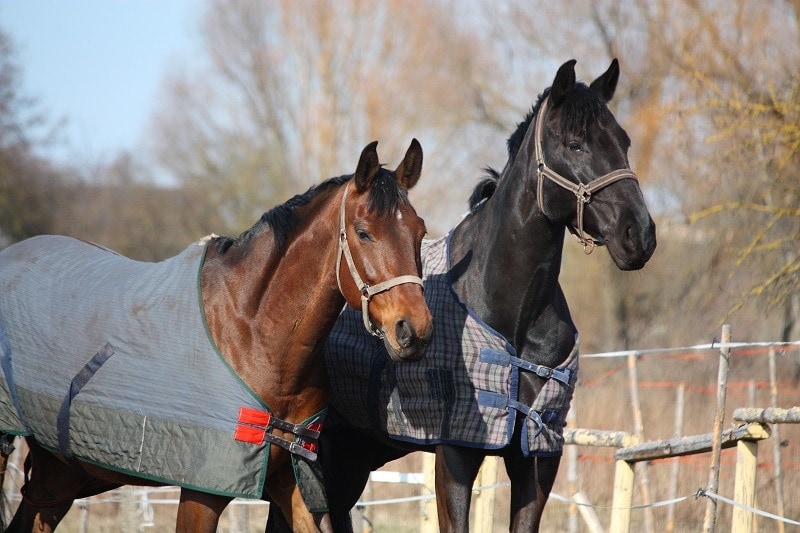
Thickness
Another common measurement is the thickness of the blanket. This is measured in denier and may be displayed as D, for example, a 600D blanket has a thickness of 600 deniers.
The thickness of the blanket usually determines how strong and tough, or how durable, the blanket is.
A thicker blanket will survive knocks, scrapes, and scratches, better than a thin one, for example. Both outdoor and indoor blankets will usually have to endure some degree of rough treatment, and if your horse likes to play with others, or if it is in a paddock with more aggressive horses, it will need a thicker blanket. The most common thicknesses are 600D or 1200D. As with weight, the denier measurement isn’t the only factor that determines ruggedness.
The material, and even the stitch or pattern of the material, also determines how well it stands up to tough treatment.
Size
You will need to measure your horse to ensure that you get the right size if you don’t already have accurate measurements. The process is much easier with a fabric tape measure and the assistance of a second person.
Place one end of the tape measure at your horse’s chest and run it around the widest part of the shoulders and towards the furthest part of the horse’s buttock. Measure around to the base of the tail, and you should get the size of blanket that your horse requires.
Opt for the larger size if your horse is between two different sizes.
Adjustable Straps
A blanket should be fixed firmly without being too tight. Even if you size accurately and ensure that you buy the right blanket dimensions, you will benefit from being able to adjust the blanket to the precise dimensions of your horse.
Adjustable straps and rings enable you to do exactly this. Look for adjustable front buckles if you want to ensure a snug fit. Adjustable buckles may be quick-clip, which are easy to use but are another section of the blanket that can break and go wrong, or standard, which do require both hands and more work to adjust but are less likely to become damaged or broken.
Surcingle closures are considered an alternative to adjustable buckles. These are fixed rings, and they cannot be adjusted. If your horse is a somewhat standard size and has standard dimensions, or if you know the precise measurements of a particular blanket, these can work well.
Additional Components
- Tail Flaps: A tail flap is a flap that sits over your horse’s tail. It is designed to not only protect the tail but to prevent wind from blowing rain up and under the blanket from the rear. The two-piece design still allows your horse to comfortably move its tail around. Tail flaps are usually available as standard or large. Large flaps offer greater protection but can get in the way of a smaller horse.
- Leg Straps: Leg straps attach the blanket to the horse’s legs. This prevents it from rotating around the horse and getting twisted. A twisted blanket does not offer the protection it should, and it can become very uncomfortable for the horse. An alternative to leg straps is a tail cord, which runs under the tail and connects the ends of the blanket. Both perform the same function but you or your horse may have a preference for one style or the other.
- Surcingles: Another method used to prevent the rotation and squeezing of the blanket is the belly surcingle. There are usually two or three of these components on the underside of the blanket and they can be very effective at preventing horses from escaping their blankets.
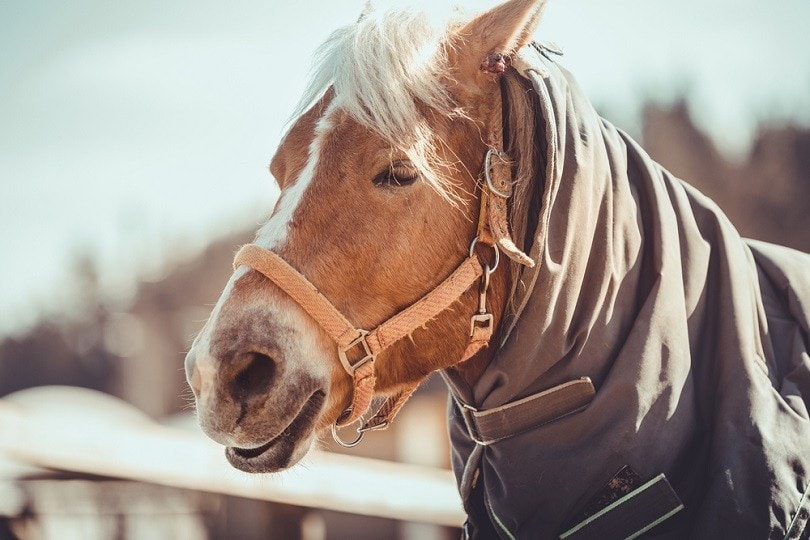
Benefits of a Horse Blanket
The primary purpose of blanketing a horse is to protect them from harsh weather conditions. They keep horses warm in the cold and dry in the rain. They should be considered essential if your horse has been clipped and it turns cold, even if they are in stabling.
Some argue horses do not need blanketing in winter because the horse, as a breed, has spread across the world and adapted to different weather conditions wherever they go. It is also true that many horses survive perfectly well in cold and wet conditions.
However, your horse has not adapted to the external conditions in which it lives. This is especially true if you stable your horse and if you own a horse that is not indigenous to the area where you live. It is also true if you live in extremely cold environments where the temperature routinely passes below the 10º Fahrenheit mark.
With that said, it is, ultimately, down to you, as a horse owner, to determine whether yours requires the additional protection of a blanket during cold or wet weather.
When Should I Blanket My Senior Horse?
It is worth considering a blanket for a senior horse, especially if it has lost weight and is looking thinner. If your horse is shivering, it’s a good sign that it would benefit from having a blanket. You can layer blankets to provide the level of insulation that your horse requires, so start with a thin blanket, change to a cooler if the weather gets really cold, and keep a rain sheet to hand in case of any unexpected downpours.
Should You Blanket a Wet Horse?
There is no simple or single answer to this question. In some cases, it should be fine to blanket a wet horse. Before doing so, ensure that the blanket has a breathable inner liner. If it does, it should wick moisture safely away from the body. Use a fleece cooler, because these also naturally wick moisture away and therefore promote dryness for your horse. Wool dries as it does this, but fleece remains wet, so is not a good option in this case.
If your blankets do not have a breathable inner and are not made from wicking material like wool, you will need to dry your horse before covering up with a blanket or they will remain wet.
How Long Do Horse Blankets Last?
How long a horse blanket lasts depends on the type and quality of the blanket, as well as how well they are treated and how often they are used. A good waterproofing coat should last a year. This can be retreated and used for another year, but it may prove less expensive and simpler to replace the blanket with a new waterproof.
Those without a waterproof outer can last longer, especially if your horse is gentle with it and you take good care of it between uses.
Conclusion
Hopefully, our reviews have helped you find the best blanket for your needs.
Although the ideal blanket will vary on factors like horse condition and the prevailing weather conditions, we found the Derby Originals 600D Turnout Horse Blanket to be the best overall blanket. It has 250 grams of polyfill lining wrapped in a 600D waterproof liner and is a reasonable price for a good quality blanket. The Shires Tempest Original Lite Turnout Blanket is a cheaper alternative that effectively offers protection against the rain and damp for less money.



